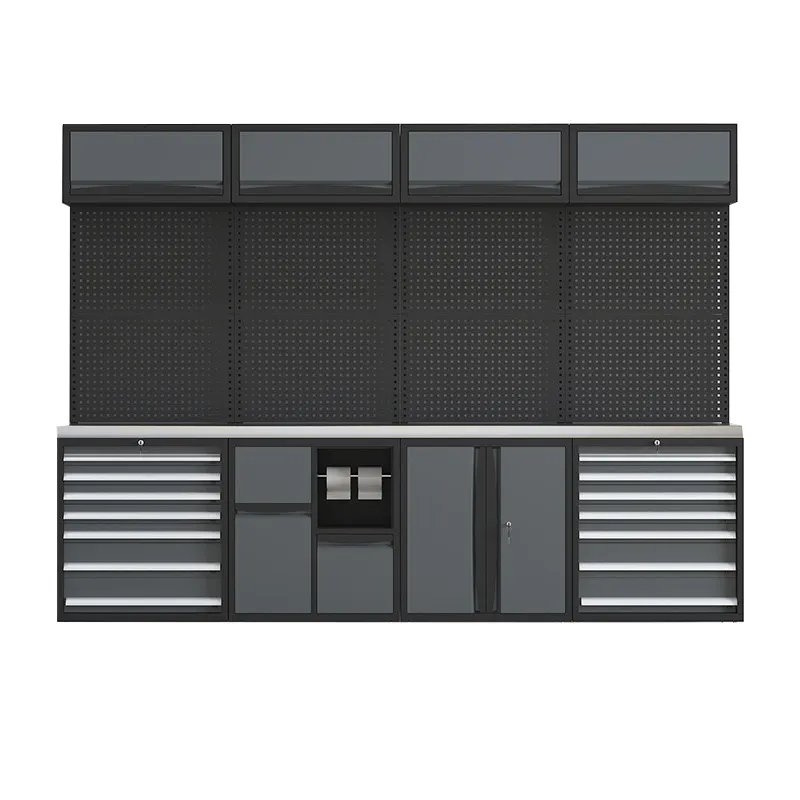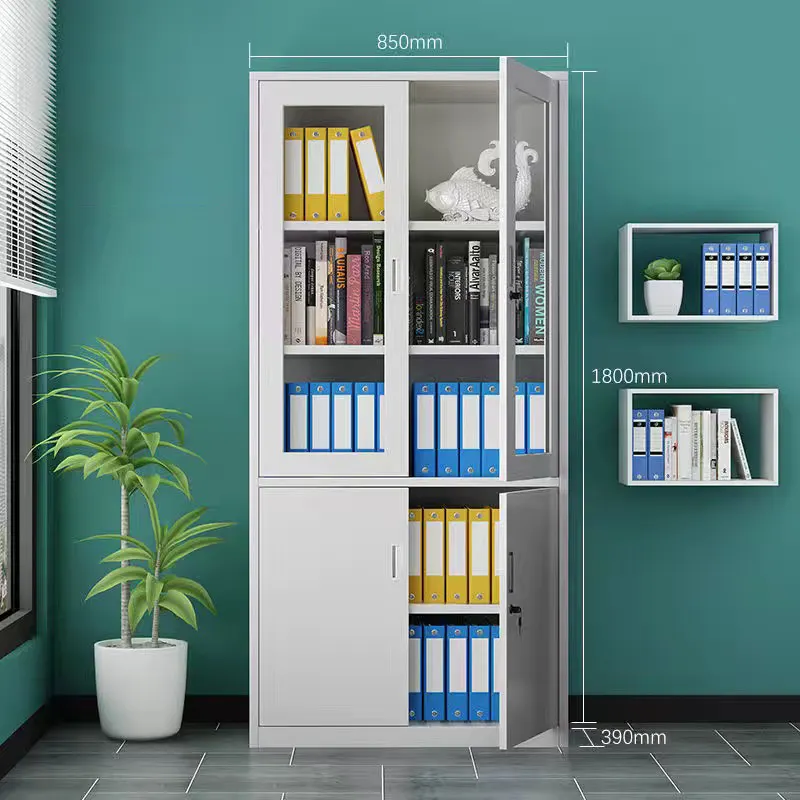התפקיד החיוני של מערכות קבצים מודרניות במוסדות חינוכיים
ארגזי תיעוד משרתים כבר זמן רב כעמוד השדרה לניהול מסמכים בסביבות חינוכיות, ומציעים גישה מבנית לארגון ושמירת מידע חשוב. בבתי ספר וספריות ברחבי העולם, פתרונות האחסון הללו ממשיכים למלא תפקיד מרכזי בשמירה על הסדר וקלות הגישה לחומרים חשובים. מרשומות תלמידים ועד מאמרי מחקר, הארגון השיטתי שמציעי הקבצים ארגזים מבטיחים כי מוסדות חינוכיים יכולים לנהל ביעילות את אוספם הגדל והנשגב של מסמכים, תוך שמירה על קלות הגישה לעובדים ולמנהליים.
מוסדות חינוכיים מתקדמים עומדים בפני האתגר המתמיד של איזון בין המרת מסמכים לדיגיטל לבין הניהול המסורתי של מסמכים. למרות שרבים מהמוסדות מאמצים פתרונות דיגיטליים, ארון מסמכים נותרו חיוניים לשמירת מסמכים מקוריים, תחזוקת גיבויים ושמירה על תקנות הניהול. היותם עמידים, בעלי תכונות אבטחה ויכולות ארגון מעשיות הופכות אותם למרכיב חיוני בכל מערכת ארכיון מקיפה.
אופטימיזציה של ניהול מסמכים בסביבות חינוכיות
מערכות ארגון אסטרטגיות
ארונות מסמכים מאפשרים לבתי ספר ולibraries להטמעת מערכות ארגון מתקדמות שמשפרות את יעילות השחזור של המסמכים. באמצעות שימוש בסיווג צבעוני, סידור אלפביתי ולABELING שיטתי, הצוות יכול לאתר במהירות לגשת לחומרים הנדרשים. הגישה המאורגנת הזו חוסכת זמן יקר ופוחתת את הfrustration שלעיתים מלווה את החיפוש אחר מסמכים מסוימים בארכיונים מוסדיים גדולים.
מוסדות חינוכיים יכולים למקסם את השימוש בארונות הקבצים שלהם על ידי יישום פרוטוקולי סיווג ברורים. לדוגמה, קבצי תלמידים יכולים להיות מסודרים לפי שנת הסיום ולאחר מכן לפי סדר אלפביתי, בעוד קבצי מינהל יכולים להיות מסודרים לפי מחלקה ותאריך. גישה שיטתית זו מבטיחה עקביות בין משתמשים ומחלקות שונות, מה שעושה את הניהול של הקבצים להיות אינטואיטיבי ויעיל יותר.
אופטימיזציה של מרחב והנגישות
ארונות קבצים מודרניים נועדו להגביר את נפח האיחסון האנכי תוך שמירה על נגישות למסמכים. הרגל הקטנה שלהם מאפשרת לבתי ספר ולibraries לאחסן כמויות גדולות של רשומות מבלי להתפשר על שטח הרצפה היקר. תכונות מתקדמות כמו מגררות מתארכות וכפפות ארגונומיות הופכות את הגישה לקבצים לנחמה עבור הצוות לאורך היום.
האופי המודולרי של ארון הקבצים מאפשר גם כן למוסדות להרחיב את נפח האחסון שלהם לפי הצורך. על ידי בחירת יחידות תואמות, בתי ספר וספריות יכולים ליצור פתרונות אחסון מקיפים שצומחים יחד עם צורכי הארכיון שלהם. היכולת להרחיב מראה על פונקציונליות וערך לטווח ארוך עבור תשתיות חינוכיות.

Bezpieczeństwo i korzyści w zakresie zachowania wartości
Measures for the Protection of Documents
ארונות קבצים מספקים הגנה חיונית לרשומות חינוכיות רגישות ולמסמכים בעלי ערך. יחידות באיכות גבוהה מצוידות בתכונות עמידות בפני אש ותכונות נגדיות למים, ומשמרות מסמכים חשובים מפני אסונות פוטנציאליים. מנגנוני נעילה מבטיחים כי מידע סודי יישאר מאובטח, ועוזרים למוסדות לעמוד בדרישות הגנת הפרטיות וחוקי הגנת הנתונים.
הסביבה המנוטרת בתוך ארון הקבצים עוזרת גם לשמירה על המסמכים מפני גורמים סביבתיים כמו אבק, חשיפה לאור ולחות. הגנה זו היא חשובה במיוחד לספריות השומרות על ספרים נדירים, מסמכים היסטוריים או חומרי מחקר שאינם ניתנים להחלפה, הדורשים שימור זהיר.
בקרת גישה וامتثال
מוסדות חינוכיים חייבים לשמור על שליטה מחמירה על מי יכול לגשת למסמכים מסוימים, וכן ארון הקבצים מקדם זאת באמצעות תכונות אבטחה שונות. ניתן ליישם רמות גישה שונות באמצעות מערכות מפתחות, נעילי צירוף או אמצעי אבטחה אלקטרוניים. בקרת הגישה ההיררכית הזו עוזרת לשמירה על שלמות המסמכים ומבטיחה עמידה בחוקים הנוגעים zur פרטיות חינוכית.
ארונות קבצים מודרניים כוללים לרוב יכולות של דוחות ביקורת, המאפשרים למנהלי מערכת לעקוב אחרי מי גישה מסמכים מסוימים ומתי. תכונת האחריות הזו היא חסרת ערך בהתחשב בשמירה על פרוטוקולי אבטחה ובהגשמת דרישות רגולטוריות בסביבות חינוכיות.
אינטגרציה עם מערכות דיגיטליות
פתרונות איחסון היברידיים
בעוד המעבר הדיגיטלי נמשך במוסדות חינוכיים, ארונות הקבצים ממלאים תפקיד מרכזי בפתרונות האיחסון ההיברידיים. הם משמשים איחסון מאובטח למסמכים מקוריים, בזמן שעותקים דיגיטליים נשמרים במערכות האלקטרוניות. הגישה הכפולה הזו מבטיחה כפילות ומספקת מערכת גיבוי אמינה למסמכים קריטיים.
שילובן של מערכות אחסון פיזיות ודיגיטליות מאפשרות למוסדות לשמור על היתרונות של שני העולמות. ארון קבצים מספק גישה מוחשית למסמכים מקוריים כשנדרש, בעוד מערכות דיגיטליות מציעות חיפוש מהיר ויכולת גישה מרחוק. גישה משלימה זו הוכחה כמועילה במיוחד במהלך מעבר לפלטפורמות דיגיטליות.
ניהול מסמכים להגנה על עתיד
בהתאם להתפתחותן של מוסדות חינוכיים, ארון הקבצים ממשיך להתאים עצמו עם תכונות ויכולות חדשות. יחידות מודרניות יכולות להיות מצוידות במערכות ברקוד, זיהוי|RFID או קודים דו-ממדיים שמקשרים מסמכים פיזיים למערכות ניהול דיגיטליות. שילוב טכנולוגי זה משפר את מעקב המסמכים ומעלים את היעילות הכוללת של ניהול הארכיון.
העמידות והאמינות של ארון הקבצים מבטיחה שעל אף התקדמות הטכנולוגיה, יש לאחסון המסמכים בסיס יציב. תפקודם בתמיכה בשיטות ארכיון מסורתיות ומודרניות הופכת אותם לפתרון מתמשך עבור בתי ספר וספריות.
שאלות נפוצות
איזה סוג ארון קבצים מתאים ביותר למוסדות חינוכיים?
מוסדות חינוכיים נהנים לרוב מארונות אופקיים כבדים בעלי תכונות התנגדות לאש ומנועלים בטוחים. יש לחפש יחידות עם תאים שזזים חלק, נפח אחסון גדול, ואף אפשרויות להרחבה כאשר צרכי האחסון גדלים.
איך בתי ספר יכולים למקסם את נפח האחסון בארון הקבצים?
בתי ספר יכולים למקסם את השימוש בתריסים על ידי יישום מערכות ארגון ברורות, שימוש בארונות תלייה עם כרטיסים, ניצול מחלקים לתאים ופינוי תדיר של מסמכים מיושנים. ניתן למקסם את השימוש במרחב האנכי על ידי בחירת תריסים עם תאים שניתן למשוך במלואם ועם גובה המתאים לחדר הפנוי.
כמה זמן על מוסדות חינוכיים לשמור על מסמכים בארונות לקבצים?
תקופות השמירה על מסמכים משתנות בהתאם לסוג ולתקנות המקומיות. בדרך כלל, יש לשמור על רישומי תלמידים מספר שנים לאחר הסיום, בעוד שמסמכים מנהלתיים עשויים להיות כפופים לדרישות שמירה שונות. המוסדות צריכים לפתח מדיניות ברורה לשימור מסמכים בהתאם לדרישות חוקיות וצרכים מעשיים.
האם ניתן לשלב תריסים עם תוכנות ניהול מסמכים מודרניות?
כן, ניתן לשלב ארגזות קבצים מודרניות עם תוכנות ניהול מסמכים באמצעות מערכות ברקוד, זיהוי|RFID|או קודים דו-ממדיים. שילוב זה מאפשר מעקב יעיל אחר המסמכים הפיזיים תוך שמירה על רשומות דיגיטליות של מיקומם וסטטוסם.

